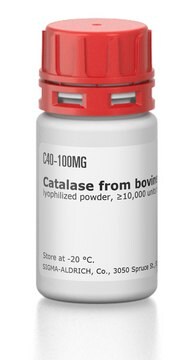MABN1843
Anti-SET (I2PP2A) Antibody, N-term Antibody, clone 10E7
clone 10E7, from mouse
Synonym(e):
Protein SET, HLA-DR-associated protein II, IGAAD, Inhibitor of granzyme A-activated DNase, PHAPII, I-2PP2A, Phosphatase 2A inhibitor I2PP2A, TAF-I, Template-activating factor I
About This Item
Empfohlene Produkte
Biologische Quelle
mouse
Qualitätsniveau
Antikörperform
purified immunoglobulin
Antikörper-Produkttyp
primary antibodies
Klon
10E7, monoclonal
Speziesreaktivität
rat, human, monkey
Methode(n)
western blot: suitable
Isotyp
IgG2aκ
NCBI-Hinterlegungsnummer
UniProt-Hinterlegungsnummer
Versandbedingung
ambient
Posttranslationale Modifikation Target
unmodified
Angaben zum Gen
human ... SET(6418)
Allgemeine Beschreibung
Spezifität
Immunogen
Anwendung
Neurowissenschaft
Western Blotting Analysis: A representative lot detected endogenous monkey SET (I2PP2A) as well as full-length human SET constructs (Wild-type, R179A/K180A/R181A, K168A/R169A) exogenously expressed in COS-7 cells (Arif, M., et al. (2014). J. Biol. Chem. 289(40):27677-27691).
Western Blotting Analysis: A representative lot detected full-length Myc-tagged human SET (I2PP2A) and its N-terminal cleavage product (NCP) in transfected COS-7 cells. Only NCP and Asn endopeptidase-/AEP-cleaved N-terminal fragment I2NTF, but not the full-length SET, were detected in COS-7 co-transfected with full-length SET and AEP, while acidic pH treatment of the COS-7 transfectants resulted in the detection of only I2NTF, but not NCP (Basurto-Islas, G., et al. (2013). J. Biol. Chem. 288(24):17495-17507).
Western Blotting Analysis: A representative lot detected both endogenous SET (I2PP2A) in untransfected PC12 cells and exogenously overexpressed SET (I2PP2A) in PC12 rat adrenal pheochromocytoma cells.
Qualität
Western Blotting Analysis: 0.5 µg/mL of this antibody detected SET (I2PP2A) isoforms in 10 µg of Jurkat cell lysate.
Zielbeschreibung
Physikalische Form
Lagerung und Haltbarkeit
Sonstige Hinweise
Haftungsausschluss
Sie haben nicht das passende Produkt gefunden?
Probieren Sie unser Produkt-Auswahlhilfe. aus.
Lagerklassenschlüssel
12 - Non Combustible Liquids
WGK
WGK 1
Flammpunkt (°F)
Not applicable
Flammpunkt (°C)
Not applicable
Analysenzertifikate (COA)
Suchen Sie nach Analysenzertifikate (COA), indem Sie die Lot-/Chargennummer des Produkts eingeben. Lot- und Chargennummern sind auf dem Produktetikett hinter den Wörtern ‘Lot’ oder ‘Batch’ (Lot oder Charge) zu finden.
Besitzen Sie dieses Produkt bereits?
In der Dokumentenbibliothek finden Sie die Dokumentation zu den Produkten, die Sie kürzlich erworben haben.
Unser Team von Wissenschaftlern verfügt über Erfahrung in allen Forschungsbereichen einschließlich Life Science, Materialwissenschaften, chemischer Synthese, Chromatographie, Analytik und vielen mehr..
Setzen Sie sich mit dem technischen Dienst in Verbindung.







